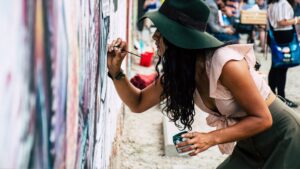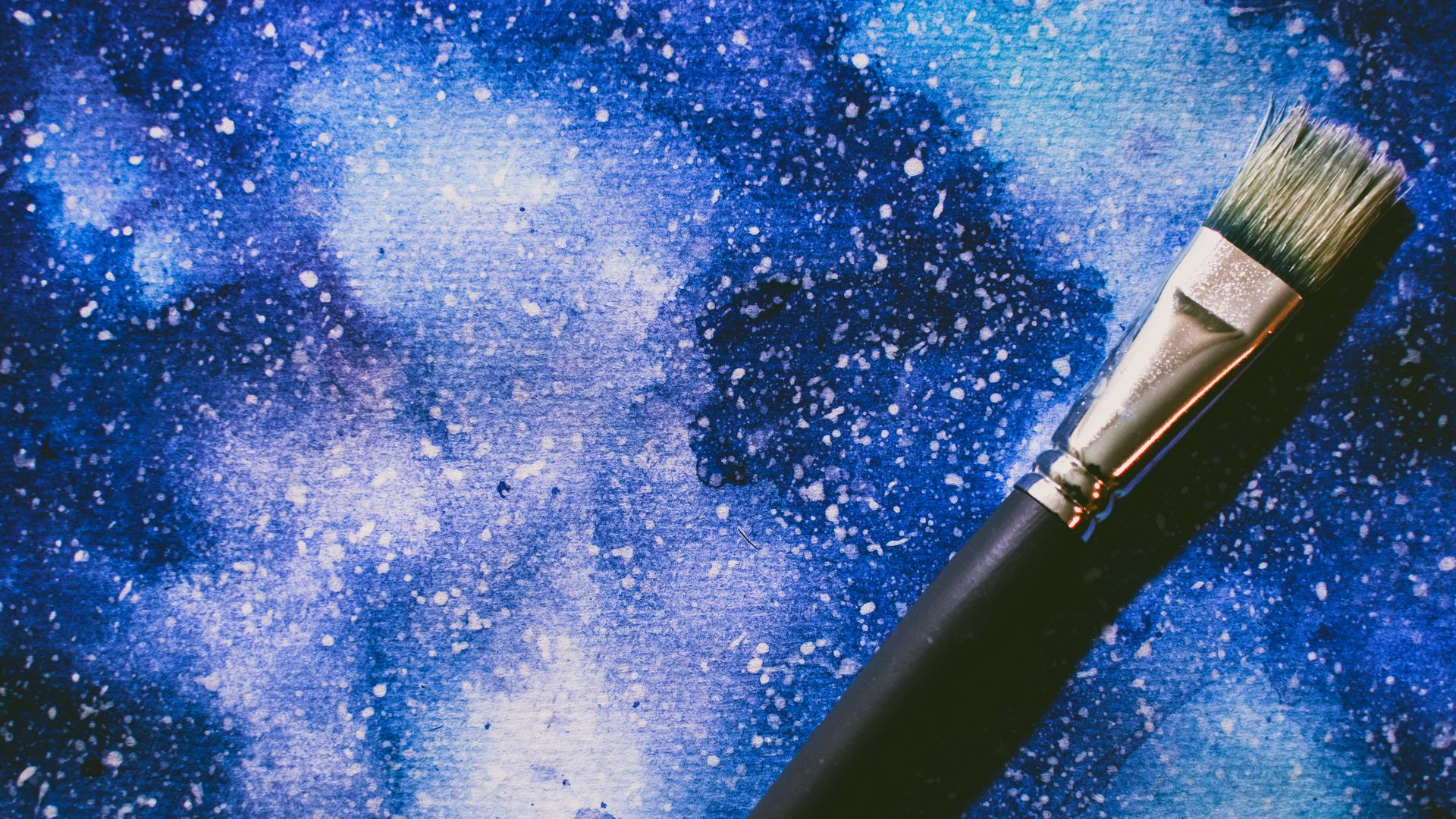Adding a mural to a cinder block surface can transform a dull wall into a vibrant masterpiece. Yet, ensuring a smooth, flawless finish isn’t always straightforward. One common challenge is avoiding paint drips or streaks that might mar your artistic vision. Fear not. Here are some pro tips to help you navigate this hurdle and achieve a stunning mural without those pesky imperfections.
Understanding the Surface
Cinder blocks, with their porous texture, tend to absorb paint differently than smoother surfaces. This variance can result in uneven application and, subsequently, drips or streaks. Preparing the surface is crucial to overcoming this obstacle.
1. Surface Preparation
Before picking up your brush, ensure the cinder block surface is clean and dry. Remove any dirt, dust, or loose particles by scrubbing it gently with a wire brush and then washing it down with mild soap and water. Allow it to completely dry before painting.
2. Primer Magic
Priming the surface is a game-changer. Choose a high-quality primer designed specifically for masonry or concrete surfaces. Apply a uniform coat, and let it dry thoroughly according to the manufacturer’s instructions. This step creates a smooth base for the paint to adhere to, reducing the likelihood of drips or streaks.
Paint and Technique
The type of paint and your painting technique play pivotal roles in achieving a flawless mural.

3. Paint Selection
Opt for acrylic or latex paint formulated for masonry surfaces. These paints are designed to resist moisture and adhere better to porous materials like cinder blocks, reducing the chances of drips or streaks. Consider choosing a paint with a satin or semi-gloss finish for better durability and easier cleaning.
4. Technique Matters
When applying the paint, use a high-quality paintbrush or a roller designed for textured surfaces. Start with thin coats and apply additional layers as needed once each coat dries completely. Avoid overloading the brush or roller to prevent excess paint buildup that could lead to drips.
5. Patience is Key
Allow each coat to dry thoroughly before applying the next. Rushing this step can result in uneven drying and, consequently, paint drips or streaks. Follow the paint manufacturer’s recommended drying times between coats.
So,…
understanding the surface, using the right materials, and employing proper painting techniques, you can create a stunning mural on cinder block surfaces without worrying about those unwelcome drips or streaks. Remember, preparation, patience, and the right tools are your best allies in achieving mural perfection.
External Resources for Further Guidance:
- The Spruce – How to Paint a Concrete Wall
- Sherwin-Williams – Painting Concrete Block
- Bob Vila – Painting Cinder Block
These resources offer detailed guidance on painting concrete and cinder block surfaces, providing additional insights and tips to enhance your mural painting experience.
Remember, with the right approach and a touch of creativity, your mural will shine without a single drip or streak.
let’s delve further into some additional steps and best practices to ensure your mural painting journey on cinder block surfaces remains as seamless as possible.
Navigating Potential Challenges
6. Weather Conditions
Pay attention to the weather when planning your mural project. Avoid painting during extremely hot, cold, or humid conditions, as these factors can affect paint application and drying. Optimal painting conditions usually include temperatures between 50°F to 85°F (10°C to 29°C) with moderate humidity levels.
7. Stirring and Straining
Before starting, thoroughly stir the paint to ensure consistent color and texture. Additionally, strain the paint through a mesh strainer to remove any lumps or impurities that might cause irregularities during application.
8. Test and Assess
Consider doing a small test patch on an inconspicuous area of the cinder block wall before diving into the full mural. This allows you to assess how the paint interacts with the surface and helps you adjust your technique if needed.
Maintenance for Longevity
9. Sealing the Deal
Once your mural masterpiece is complete and thoroughly dried, consider applying a clear protective sealant or topcoat specifically formulated for exterior use. This extra layer of protection shields the mural from environmental elements and makes it easier to clean any future stains or dirt buildup.
10. Regular Checks and Touch-Ups
Periodically inspect your mural for any signs of wear, especially in high-traffic or exposed areas. Promptly address any chips, scratches, or fading by touching up the paint to maintain the mural’s vibrancy and overall appearance.
Conclusion
Creating a stunning mural on cinder block surfaces is an exciting endeavor that can instantly elevate the aesthetics of any space. By following these steps, you’re equipped to tackle the challenges of paint drips or streaks, ensuring a smooth and flawless finish for your artwork.
Remember, patience, preparation, and the right techniques are your allies throughout this creative process. Embrace the journey and let your artistic vision come to life on those cinder block walls!
And don’t forget, if you encounter any challenges along the way, the resources provided in the earlier section can offer additional guidance and insights to support your mural painting adventure.
Comparison tabular
| Aspect | Preparation | Paint Selection | Technique | Maintenance |
|---|---|---|---|---|
| Surface Prep | Clean & dry surface, use primer | – | – | – |
| Paint Type | – | Acrylic/Latex for masonry | – | Clear protective sealant/topcoat |
| Tools | Wire brush, mild soap, primer | – | Quality brush/roller | – |
| Application | – | Thin coats, allow drying time | Avoid overloading brush/roller | Periodic checks and touch-ups |
| Weather Consideration | – | Optimal temperature/humidity | – | – |
This table gives a snapshot comparison of the key aspects involved in mural painting on cinder block surfaces. It highlights the preparation, paint selection, techniques, and maintenance considerations. Feel free to expand upon each aspect with more detailed information based on specific techniques or products if needed.
Wrapping up
As you embark on your mural painting journey on cinder block surfaces, remember that every stroke of the brush holds the potential to transform a blank wall into a vibrant story. Embrace the preparation process as the foundation of your masterpiece; it sets the stage for a flawless finish.
Choosing the right paint, tools, and techniques paves the way for a smooth and captivating mural. Patience is your guiding star; allow each layer to dry thoroughly, layering your vision with care and precision.
Once your artwork graces the wall, nurturing its longevity becomes essential. A protective sealant becomes its shield against time and the elements, ensuring its brilliance endures.
May your creative spirit flow freely, igniting colors that captivate and narratives that resonate. Your mural is more than pigment on a wall; it’s a testament to imagination, dedication, and the beauty of expression.
So, gather your tools, envision your masterpiece, and paint the world with your creativity. Happy mural painting!

For over a decade, I’ve been Mike, an artist, crafter, and designer deeply immersed in the Croc world. I thrive on crafting unique, size-inclusive patterns, fostering creativity, and sharing them on ktforum.com. My designs aim to ignite your creative spark and delight you, ensuring clarity and ease of use through rigorous testing. Join me in expressing your creative flair and showcasing your craft with joy.
Related Posts
- Painting a Mural on Damp Cinder Block Surfaces: What You Need to Know
When it comes to painting murals on surfaces like damp cinder blocks, there are a…
- The essential tools needed for painting a mural on a cinder block wall
Painting a mural on a cinder block wall can be an incredibly rewarding and transformative…
- Painting a Mural on a Cinder Block Wall: Adding Artistry to Outdoor Spaces
Outdoor walls, especially those made of cinder blocks, offer a fantastic canvas for artistic expression.…
- Guide to Choosing the Right Primer for Painting a Mural on a Cinder Block Wall
Whether you're an experienced muralist or diving into your first large-scale painting project, preparing a…

